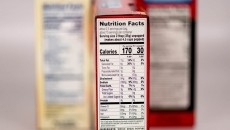Potential review of ‘ultra-processed food’ by dietary guideline committee could portend trouble for packaged food industry

As one of the first steps in updating the 2025-2030 Dietary Guidelines for Americans, the US Departments of Agriculture and Health and Human Services are calling for public comment through May 16 on a proposed list of scientific questions and topics that ultimately will be reviewed by a yet-to-be named panel of experts who will recommend updates to the pivotal document which influences what is served in schools, prisons and many US households.
As in the past, the questions focus on diet and health outcomes across life stages with special attention paid to the relationship between diet and risk of overweight and obesity.
But this time, in addition to the standard line-up of nutrients typically accused of contributing to weight gain and chronic health conditions, such as added sugar and saturated fat, the list calls out for the first time “ultra-processed foods."
The inclusion of ultra-processed foods was lauded by several public health advocates, including the Center for Science in the Public Interest senior policy associate Jessi Silverman, who noted research connecting them to overconsumption at higher frequencies than minimally processed foods.
Opening Pandora's box?
But others caution the question could open a Pandora’s box and have far reaching consequences for the consumer packaged goods industry.
“There is a growing amount of scientific evidence that ultra-processed food contributes to poor health outcomes when compared to other less processed foods, yet criticism about the strength of the evidence exists,” said Carmen Byker Shanks, principal research scientist at the Gretchen Swanson Center for Nutrition and Associate Project Director for Reporting and Evaluation of the GusNIP Nutrition Incentive Program Training, Technical Assistance, Evaluation and Information Center.
While the Dietary Guidelines Committee is well suited for sifting through and determining the value of complex and contradictory research, Shanks notes that their task will be complicated because there is no consensus on what classifies as an ultra-processed food, and questions remain about the mechanisms that lead to poor health outcomes.
“Ultra-processed foods are typically packaged, but packaged foods are not always ultra-processed,” she explained. “Since packaged foods are a large part of the modern food system, any guidance to avoid ultra-processed food should be paired with recommendations about how to read food labels and how to choose the healthiest version of a packaged food.”
Not all processed foods are created equal
Agreeing that “all processed foods are not created equal,” the Dietary Guidelines will need to carefully define ‘ultra-processed’ to empower Americans to make healthy choices based on nutritional evidence and not inadvertently create a barrier to healthy eating, said Joseph Clayton, CEO, International Food Information Council.
“The term ‘ultra-processed’ can have little do with nutritional value or health benefits” as illustrated by some processed foods being nutrient-dense and made of relatively few ingredients while others are energy dense and contain higher amounts of added sugar, sodium and saturated fat, he said.
“Classification systems like NOVA [which groups food according to the nature, extent and purposes of the industrial processes and includes ‘ultra-processed’] are based on the extent of processing involved in a product’s final form, not on its nutritional value or health benefits,” he added.
Added sugar, saturated fat, beverages in crosshairs
Other nutrients suggested for consideration by the dietary guidelines review committee for how they impact Americans’ health and weight include several that have been in the crosshairs before, including added sugar, saturated fat and beverages.
Added sugars are tackled in the most recent 2020-2025 Dietary Guidelines but, according to CSPI’s Silverman the recommendation “is not as strong as it could have been.”
Heartened to see on the list of potential topics a question about what the relationship is between added sugars and growth, size, body composition, risk of overweight and obesity, weight loss and maintenance and the risk of type 2 diabetes, Silverman encourages decision makers to further lower the recommended limit on added sugars from less than 10 to less than 6% of total calories as recommended by the 2020 Dietary Guidelines advisory committee.
Such a move would “benefit future updates to school meals,” which must be based on the most recent Dietary Guidelines, Silverman said, adding that “excessive added sugar in school meals and children’s diets is a threat to public health.”
What beverages should children drink and avoid?
In several ways, the recommendation that the advisory committee also review the relationship between beverage consumption and growth, size, body composition, risk of overweight and obesity, weight loss and maintenance and the risk of type 2 diabetes goes hand-in-hand with the review of added sugar.
For example, Marlene Schwartz, director of the Rudd Center for Food Policy & Health, noted the ongoing debate about whether children should consume 100% juice and if so, how much, could benefit from the rigorous review of an advisory committee.
Likewise, she’d like to see a review of the literature of the impact of low- and no-calorie sweeteners in beverages on children’s health, which she says has become “a little murky” with a lot of mixed literature.
“This is a super important question because a lot of sugar-sweetened beverages that are typically marketed to kids have been getting hammered for having so much added sugar, and so some companies are starting to swap them out with low calorie sweeteners,” which she characterized as a “pretty questionable” but acknowledged “it’d be good to see them take that on specifically.”
Beyond juice and sweetened beverages, several public health advocates noted they would like to see additional analysis on the impact of dairy milk and milk alternatives on Americans' health.
“There has been a lot of controversy in this area because some research shows that milk fat might be different [than other sources of fat]” and questions about whether whole milk, because of its high saturated fat content, is related to obesity, said Mary Story, director of the Health Eating Research National Program at the Robert Wood Johnson Foundation.
Saturated fat targeted, but red meat flies under the radar
The health impacts of saturated fat more broadly are also recommended as a topic for review, according to USDA and HHS. Specifically, the relationship between food sources of saturated fat consumed and risk of cardiovascular disease, according to the document.
While the impact of saturated fat is a point of contention and controversy, especially with the rising popularity of high-fat diets, some public health advocates do not think the question is specific enough and worry it might be a straw man for other foods of concern – namely red meat.
“Saturated fat is sometimes seen as a proxy for red and processed meats, but the messaging needs to be clear about the consumption of the actual food versus the nutrients in the food,” said Shanks.
Dietary Guidelines should address health concerns over red and processed meats
She noted that red and processed meats are notably missing from the current list of recommended questions for review and suggests they should be directly addressed in the next dietary guidelines.
“This food category has been a contentious topic in the past for inclusion in the Dietary Guidelines for Americans. Amidst growing research that high consumption has negative health consequences, directly addressing in the Guidelines at this point in time is warranted,” she said.
Silverman agreed, noting that the current guidelines send mixed messages.
“The 2020-2025 DGA encourages eating a variety of protein foods, including lean meats, poultry, eggs, seafood, beans, peas, lentils, nuts, seeds and soy products. ‘Lean meats’ presumably include lean beef and pork. However, elsewhere in the report, the DGA states that dietary patterns characterized by lower consumption of red and processed meats are associated with health benefits, including reduced risk of cardiovascular disease, type 2 diabetes, and certain types of cancer.
"And the International Agency for Research on Cancer has concluded that processed meat is a human carcinogen and unprocessed red meat is a probable human carcinogen,” Silverman said.
“This inconsistency leaves room for confusion about how lean meats fit into a healthy diet. The 2025 DGAC should review the evidence on red and processed meat and health to better inform the public about the risks of eating those foods,” she added.
Additives, contaminants, marketing missing from proposed review
While the list of proposed questions and topics is long, it is far from incomplete, according to several public health advocates – many of whom have a wish list of topics that all together far exceed the current suggestions.
Included on CSPI’s wish list is the addition of food additives and contaminants.
Acknowledging that the DGA has not historically addressed the impact of food additives, such as synthetic dyes, and food contaminants, such as heavy metals, on health, Silverman argues, “it would help reduce individuals’ dietary exposure to these substances of concern if the DGA included authoritative guidance on this topic.”
More guidance for caregivers around choosing healthy packaged foods
Others advocate for more guidance and research into the impact of marketing on dietary choices – especially for children.
“If there’s evidence of exposure to food marketing being associated with poor diet and greater risk of obesity, which according to our research there is, you’d expect to see more done in terms of limiting food marketing for some of these products, whether we call them ultra-processed or unhealthy foods,” Schwartz said.
She added: “The food industry is the one educating consumers about the dietary guidelines, not USDA. So, the food industry needs rules to be clear enough that the food industry can educate consumers safely. The marketing should be consistent with the USDA guidelines.”
Building on this, Shanks said she would like to see more guidance for caregivers around choosing healthy packaged foods – especially for toddlers and young children.
“‘Make every bite count’ is an especially useful slogan to help caretakers of children focus on nourishing foods as majority of the time during the critical developmental stages of childhood,” and reinforcing this message in the next DG could help shape healthy diets for children, she said.

















